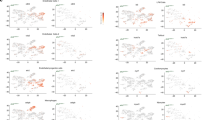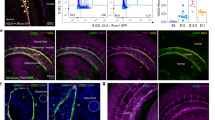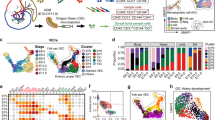Abstract
Blood vessels originate as simple endothelial cell tubes. It has been proposed that platelet-derived growth factor B polypeptide (Pdgfb) secreted by these endothelial cells drives the formation of the surrounding muscular wall by recruiting nearby mesenchymal cells1,2. However, targetted inactivation of the Pdgfb gene3 or the Pdgf receptor β(Pdgfrb) gene4, by homologous recombination, does not prevent the development of apparently normal large arteries and connective tissue. We have used an in vivo competition assay in which we prepared chimaeric blastocysts, composed of a mixture of wild-type (Pdgfrb+/+) and Pdgfrb+/− or wild-type and Pdgfrb−/− cells, and quantified the relative success of cells of the two component genotypes in competing for representation in different cell lineages as the chimaeric embryos developed. This study revealed that the participation of Pdgfrb−/− cells in all muscle lineages (smooth, cardiac, skeletal and pericyte) was reduced by eightfold compared with Pdgfrb+/+ cells, and that participation of Pdgfrb+/− cells was reduced by twofold (eightfold for pericytes). Pdgfrb inactivation did not affect cell contribution to non-muscle mesodermal lineages, including fibroblasts and endothelial cells. Chimaera competition is therefore a sensitive, quantitative method for determining developmental roles of specific genes, even when those roles are not apparent from analysis of purebred mutants; most likely because they are masked by homeostatic mechanisms.
This is a preview of subscription content, access via your institution
Access options
Subscribe to this journal
Receive 12 print issues and online access
$209.00 per year
only $17.42 per issue
Buy this article
- Purchase on Springer Link
- Instant access to full article PDF
Prices may be subject to local taxes which are calculated during checkout
Similar content being viewed by others
References
Folkman, J. & D'Amore, P.A. Blood vessel formation: what is its molecular basis? Cell 87, 1153–1155 (1996).
Holmgren, L., Glaser, A., Pfeifer-Ohlsson, S. & Ohlsson, R. Angiogenesis during human extraembryonic development involves the spatiotemporal control of PDGF ligand and receptor gene expression. Development 113, 749–754 (1991).
Leveen, P. et al. Mice deficient for PDGF B show renal, cardiovascular, and hematological abnormalities. Genes Dev. 8, 1875–1887 (1994).
Soriano, P. Abnormal kidney development and hematological disorders in PDGF beta- receptor mutant mice. Genes Dev. 8, 1888–1896 (1994).
Palmer, S.J. & Burgoyne, P.S. In situ analysis of fetal, prepuberal and adult XX-XY chimaeric mouse testes: Sertoli cells are predominantly, but not exclusively, XY. Development 112, 265–268 (1991).
Quinn, J.C., West, J.D. & Hill, R.E. Multiple functions for Pax6 in mouse eye and nasal development. Genes Dev. 10, 435–446 (1996).
Deng, C. et al. Fibroblast growth factor receptor-1 (FGFR-1) is essential for normal neural tube and limb development. Dev. Biol. 185, 42–54 (1997).
Shalaby, F. et al. A requirement for Flk1 in primitive and definitive hematopoiesis and vasculogenesis. Cell 89, 981–990 (1997).
Lindahl, P., Johansson, B.R., Leveen, P. & Betsholtz, C. Pericyte loss and mkroaneurysm formation in PDGF-B-deficient mice. Science 277, 242–245 (1997).
Topouzis, S. & Majesky, M.W. Smooth muscle lineage diversity in the chick embryo. Two types of aortic smooth muscle cell differ in growth and receptor-mediated transcriptional responses to transforming growth factor-beta. Dev. Biol. 178, 430–445 (1996).
Smits, A. et al. Rat brain capillary endothelial cells express functional PDGF B-type receptors. Growth Factors 2, 1–8 (1989).
Barrett, T.B., Seifert, R.A. & Bowen-Pope, D.F. Regulation of platelet-derived growth factor receptor expression by cell context overrides regulation by cytokines. J. Cell. Physiol. 169, 126–138 (1996).
Terracio, L. et al. Induction of platelet-derived growth factor receptor expression in smooth muscle cells and fibroblasts upon tissue culturing. J .Cell. Biol. 107, 1947–1957 (1988).
Milner, D.J., Weitzer, G., Tran, D., Bradley, A. & Capetanaki, Y. Disruption of muscle architecture and myocardial degeneration in mice lacking desmin. J. Cell. Biol. 134, 1255–1270 (1996).
Yablonka-Reuveni, Z., Balestreri, T.M. & Bowen-Pope, D.F. Regulation of proliferation and differentiation of myoblasts derived from adult mouse skeletal muscle by specific isoforms of PDGF. J. Cell. Biol. 111, 1623–1629 (1990).
Jin, P., Sejersen, T. & Ringertz, N.R. Recombinant platelet-derived growth factor-BB stimulates growth and inhibits differentiation of rat L6 myoblasts. J. Biol. Chem. 266, 1245–1249 (1991).
Jin, P., Farmer, K., Ringertz, N.R. & Sejersen, T. Proliferation and differentiation of human fetal myoblasts is regulated by PDGF-BB. Differentiation 54, 47–54 (1993).
Yaffe, D. & Saxel, O. Serial passaging and differentiation of myogenic cells isolated from dystrophic mouse muscle. Nature 270, 725–727 (1977).
Lee, S.L., Tourtellotte, L.C., Wesselschmidt, R.L. & Milbrandt, J. Growth and differentiation proceeds normally in cells deficient in the immediate early gene NGFI-A. J. Biol. Chem. 270, 9971–9977 (1995).
Wang, Y., Schnegelsberg, P.N., Dausman, J. & Jaenisch, R. Functional redundancy of the muscle-specific transcription factors Myf5 and myogenin. Nature 379, 823–825 (1996).
Lo, C.W., Coulling, M. & Kirby, C. Tracking of mouse cell lineage using microinjected DNA sequences: analyses using genomic Southern blotting and tissue-section in situ hybridizations. Differentiation 35, 37–44 (1987).
West, J.D., Keighren, M.A. & Flockhart, J.H. A quantitative test for developmental neutrality of a transgenic lineage marker in mouse chimaeras. Genet. Res. 67, 135–146 (1996).
Wilkens, A.S. Genetic analysis of animal development, (Wiley Inc., New York, 1986).
Soriano, P. & Jaenisch, R. Retroviruses as probes for mammalian development: allocation of cells to the somatic and germ cell lineages. Cell 46, 19–29 (1986).
West, J.D., Bucher, T., Linke, I.M. & Dunnwald, M. Investigation of variability among mouse aggregation chimaeras and X- chromosome inactivation mosaics. J. Embryol. Bxp. Morphol. 84, 309–329 (1984).
Musci, T.S. & Mullen, R.J. Cell mixing in the spinal cords of mouse chimaeras. Dev. Biol. 152, 133–144 (1992).
Author information
Authors and Affiliations
Corresponding author
Rights and permissions
About this article
Cite this article
Crosby, J., Seifert, R., Soriano, P. et al. Chimaeric analysis reveals role of Pdgf receptors in all muscle lineages. Nat Genet 18, 385–388 (1998). https://doi.org/10.1038/ng0498-385
Received:
Accepted:
Issue Date:
DOI: https://doi.org/10.1038/ng0498-385
This article is cited by
-
Lessons from mouse chimaera experiments with a reiterated transgene marker: revised marker criteria and a review of chimaera markers
Transgenic Research (2015)
-
Detachment of Brain Pericytes from the Basal Lamina is Involved in Disruption of the Blood–Brain Barrier Caused by Lipopolysaccharide-Induced Sepsis in Mice
Cellular and Molecular Neurobiology (2009)
-
Growth factor signaling pathways in vascular development
Oncogene (1999)



